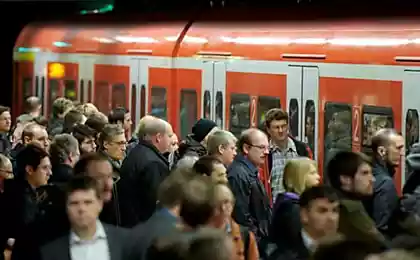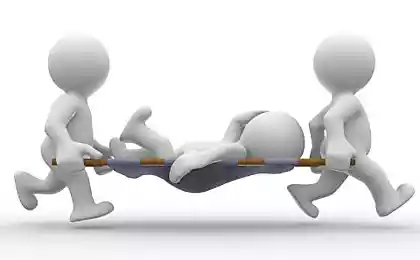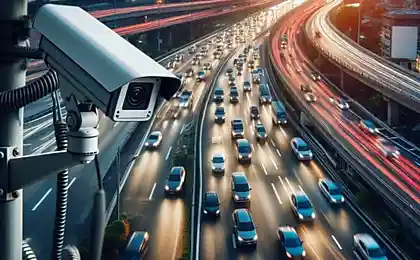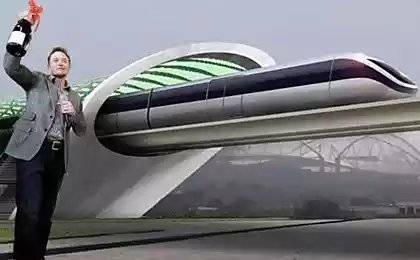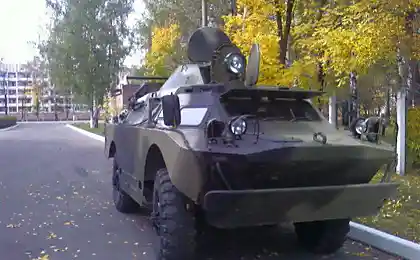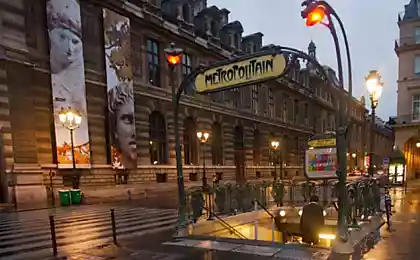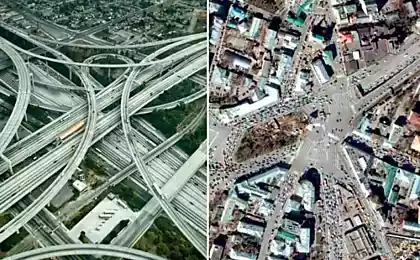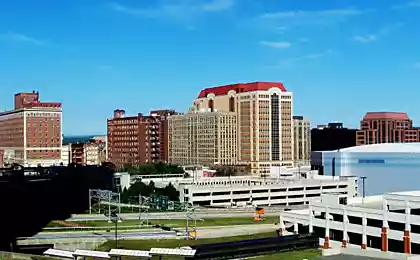930
Transportation inconsistency
13 photos + text
Draft Master Plan 2025 in the transport dimension
Mikhail Blinkin
The other day I happened to be a witness and participant in the discussion, even in part of an updated Master Plan-2025 of the Union of Architects.
I thought that 500 years ago there was a historic division of labor of the architect and design engineer; 100 years ago, with the advent of the mass of the car, another event occurred: craft Urban & Transportation Planning separated from the architecture itself. The first division we are behind the rest of the cities and countries seem to be gone; the second - alas, no.
However, the architectural community unanimously praised Master Plan. The bravest noted his individual shortcomings. The gray-haired classic Soviet architecture dare even say that it is stipulated in the document preservation radial-ring structure - a dead-end solution, and what is needed, they say, no trace of the ring, but the chords and tangents.
However, everyone, including the classic, converged on the fact that the whole project is perfectly good and should be approved immediately.
Master plan - summed up the general opinion on the sidelines of another famous architect - he is like a song: we build and live help.
I will not argue: Master plan really helps to be nice to live for those who build in Moscow. That's just everything else population - hardly ...
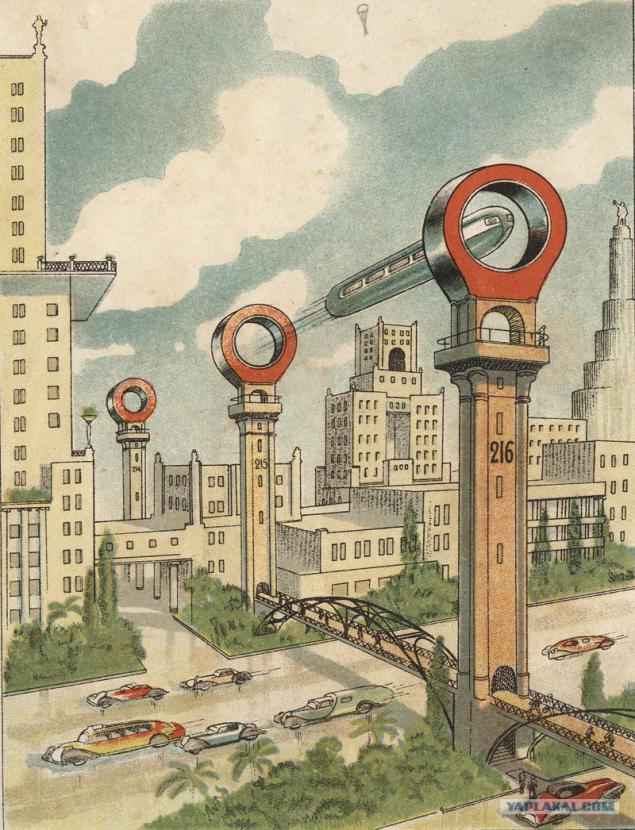
History
In 1934, the great Russian urbanist Georgy Sheleyhovsky, obviously not getting into resonance with an era of socialist urban development, he wrote that "people (in contrast to the inhabitants of the zoo!) Are free to choose the place of residence and the way of movement».
Based on the understanding of international experience, he has come to the firm conviction that this (especially valuable in itself!) Freedom of choice of the citizen is directly related to the growth of car ownership and, therefore, transport of self-sufficiency of households. His main conclusion, addressed to fellow planners, is unfortunately ostroaktualnym for Moscow today: "... if motorization came into sharp conflict with the plan, it must fight not with the motorization and the backward forms of transport - insolvent plan." < br />
These words were written relying on intellectual baggage accumulated urbanists and transport in the first decade entering cars in the life of the most advanced cities in the world. Today, this has become immeasurably more extensive luggage. It has social technologies needed for the coordination of interests of different groups of citizens in the process of making critical decisions regarding land use and transport. There is also a typical planning and technological solutions for urban centers, transportation hubs, blocks of residential development; adjusted recipes and planning for functional stratification of the road network, the device of public transport systems and the organization of parking spaces. And yet - the methods of economic, including fiscal driving behavior of citizens and, consequently, the transport demand. Well, and many other useful things, including mathematical models and IT-tools.
This baggage, in principle, allows us to solve the problem indicated Sheleyhovskim freight wealthy urban devices, absorbent arbitrarily high motorisation of households "are free to choose the place of residence and the way of movement».
All the world's mega-cities are living today at around 500-800 (in New York, even 910!) Cars per 1000 inhabitants. In Moscow, the figure is only some 350 units. This publicly available data on the conditions of transportation, environmental externalities, the preservation of cultural and historical attributes of identity show that in most of these cities is a multiple of the situation better than we have (see. Annex 1).
Motorization of the population, which successfully fought the Soviet regime, "came into sharp conflict with the plan," the Russian capital since the mid-1990s. Material Analysis Project Master Plan-2025 (2) suggests that we are not going to approach the standards of transport and wealthy city of devices; on the contrary, we are leaving them farther and farther.

Cars: a cause for bewilderment
In 1992-2008 gg. motorisation rate in Moscow grew an average annual rate of 10-11% and reached the level of the said 350 cars per 1,000 inhabitants. Authors of the General Plan 2025 based on the fact that in 2025 we will reach the mark of 380 units. This forecast implies that the city will grow motorization homeopathic pace of order 0, 6% per year. If the market would have reacted to this hypothesis any serious showrooms in Moscow, close to both the casino and gaming clubs.
I can not judge what is behind this amazing outlook: whether fitting a response arising from the planned rate of development of the road network (MAC) of the city, whether confidence will soon return to fight against motorization to the Soviet style. In any case, this prediction is not confirmed by the experience of a single major city not communist (3).
I note that exactly the same "regulatory" projections made at the end of the Soviet era, allow the city fathers say with conviction that no one will ever be able to assume such a rapid growth in motorization of the population.

Railways: a reason for cautious optimism
Sections of the General Plan 2025, which I was pleased, written on materials of the Moscow underground, and RAO Russian Railways.
I have written repeatedly that it is underground (with all the problems of its functioning and long-term development!) Keeps the city from the collapse in the transport and isolated fragments of territory. State: its development program until 2025 is structurally meaningful and realistic in principle.
In the area of urban railways and planned to do the most important structural breakthrough "development of the existing railway land diameters (Riga Kursk, Kursk, Smolensk, Smolensk-SAVELOVSKY), as well as the creation of new - Kursk Oktyabrsky and Riga-Gorky. Also for the first time it provides for the construction of two underground diameters ("deep feeding") - Yaroslavl and Paveletsky-Kiev-Ryazan ».
It is clear that the feasibility of these plans depends on the strongest fiscal space RAO Russian Railways. However, the main long-term transport planning - this is the correct ideology (4), does not contradict international experience.
In this regard, I note that the ideology of the formation of deep groundwater inputs, docked with the metro, very correct and promising. It is thus arranged off-street public transport system in the advanced foreign metropolises.
In the railway section also provides for "the reorganization of the territories at the stopping points, the creation of new urban areas, the organization of the transport of passengers by road, delaying the construction of parking lots and parking garages," plus the fact - "the organization convenient to subway hubs».
Unfortunately, here there is an obvious gap between the desirable and realistically achievable. Moscow built up the forecourt (or built up) large objects purely non-transport purposes. For example, together with the discussion of the draft of the General Plan 2025 at Paveletskaya square in full swing construction of another shopping mall, which will make their great contribution to the formation of congestion across the approaches to the square and at the same time permanently eliminate is the place for "the transportation of passengers by road" .
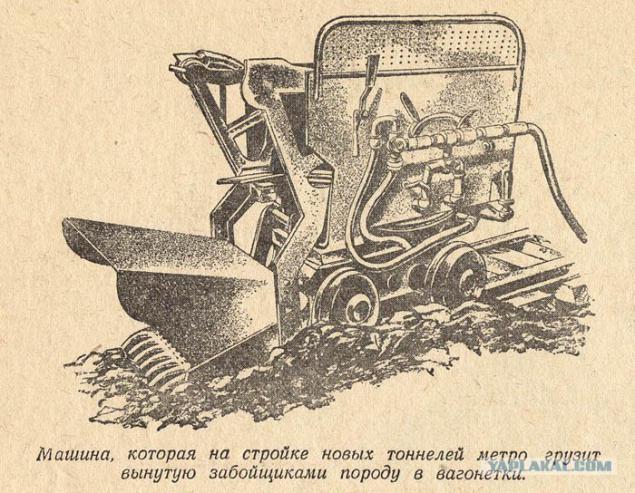
Public transport: an occasion for memories
Made by the authors of the General Plan 2025 forecast volumes and structure of passenger traffic is puzzling.
Based on the projections of the above-mentioned high-speed off-street posts, they imply an increase in, absorb, respectively, railways (2 times), and the subway (1, 46 times). Based on its forecast of motorization is undervalued, they forecast a modest (28%) increase in car trips. At the same time the Master Plan-2025 envisages a decline in land transport.
This forecast can only be based on the expectation of tremendous shift in passenger logistics. Today in Moscow, the three-tier scheme prevails: the pedestrian approach + bus (trolley bus) + Subway. Forecasted traffic structure clearly indicates the dominance of two-tier scheme: the pedestrian approach (road trip) + Subway (city w / e). The point, however, is that the transition to such a scheme there are no preconditions for planning as the characteristic step metro and urban railway / or power near-station parking.
Master plan promises that by 2025 residents will drive overland transport with the European quality under conditions not worse than 3 standing passengers per 1 m2 free floor area. Last time I had ever read such forecasts in the programs of the comprehensive building of socialism. Meanwhile, in its sunset in 1989, almost half of the traffic carried out under 6, 67 standing passengers per 1 m2 free floor area, ie at the level of the limit standard adopted by the International Union of Public Transport. Moreover, 15% of traffic took place in conditions worse than limiting technical characteristics of the bus, ie 8 passengers standing on the same square meter. Today, Delivery van routes in the periphery of the city transport passengers around in the same conditions.
Apparently the authors of the General Plan 2025, realizing the unreality of access to European standards for quality of service due to a planned (very modest!) Increase the freight capacity of public transport, resorted to means-tested Soviet forecasters: fit the demand for really affordable offer. Hence, the projected decline in land transport.
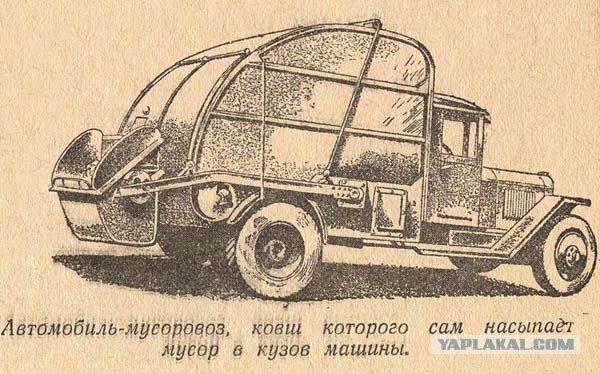
Resources adaptation: Model Park & Ride
Mass replacement car trips "home-work" travel model Park & Ride, that is, the transition to a two-tier logistics said: car ride + Subway (city w / e), called in the world is widely recognized important reserve smoothing automobile traffic.
This resource adaptation (unlike many others) discussed in detail in the materials of the General Plan 2025: to the estimated useful life is supposed to "form a cascade of intercepting parking lots with a total capacity of 250 thousand. Parking spaces." Of these total 100 thousand berths lots will be located on the way to the borders of the city, another 150 thousand - in front of the Garden Ring. Immediately, I note that parking at the turn of the Garden Ring can be called intercepting a very big stretch: in this capacity, has consistently failed to work even underground parking available at the Gagarin Square.
As for parking at the boundaries of the city, their construction certainly appropriate; the only question is, where to build them. I have carefully studied the drawings on the territorial areas adjoining the end subway stations: they are already densely packed with shopping and entertainment complexes, and other points of additional traffic generation; wherever there is room, planners partial load area "priority of capital construction projects." I'd like to know where, for example, it is possible to carve out a place for intercepting parking at the underground "South West", "Teply Stan", "textile workers" or "Riverport»!
Some indirect signs indicate that the authors of the General Plan 2025 do not really believe in the prospects of Park & Ride in Moscow. In particular, said the forecast volumes and structure of passenger traffic for 2025 was calculated in terms of passengers, and not in the passenger-kilometers, that is, in terms of identity, not kilometricheskoy mobility (5).
It is, however, evident that the use of Park & Ride model does not change the annual number of passengers transported by car households, but radically changes the parameters of their annual mileage. It seems that the authors of the General Plan 2025 previously considered model the effects of the change of movement is simply irrelevant.
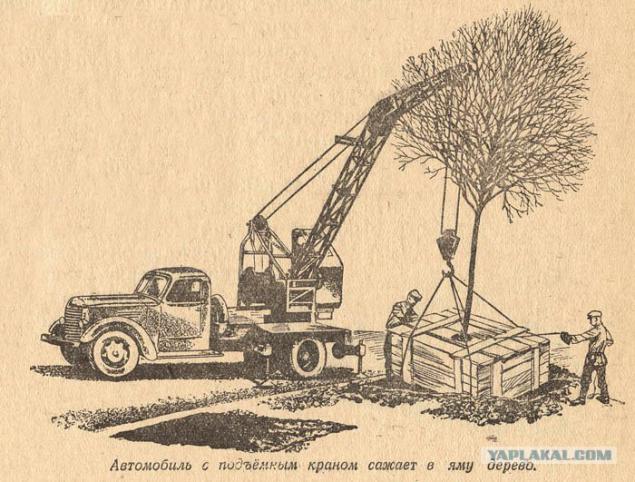
Resources adaptation: equipping the periphery
Planners of the world's mega-cities for decades seeking reserves smoothing and road passenger traffic due to the factors placing jobs and resident household behavior.
According to the famous Russian urbanist A.I.Strelnikova 38% of all the jobs available in the Moscow metropolitan area (6), is concentrated in the central patch, it takes only 6, 5% of the face of the urban area. This incredible concentration of jobs is the most powerful pendulum flows (in the center - in the morning, from the center - in the evening), the problem of development that planners in Moscow are trying to solve the increasing capacity of radial roads.
At the same time they have a natural desire to somehow move to the periphery of the point of attraction of labor trips. Unfortunately, jobs in modern Moscow is very difficult, sometimes impossible, to shift to the periphery for purely transport reasons: density and connectivity MAC fall strictly in our city as the distance from the center.
For 10-15 years of intensive road construction traffic situation on the periphery of Moscow has become not better, but rather worse.
Driving conditions in the peripheral parts of the city (such as contiguity Lublin street in Volgograd prospectus, Ural street to Schelkovskoye highway Novoyasenevskogo prospectus to Profsoyuznaya street or Kotlakovsky travel to Kashirke, as well as in the vicinity of many peripheral metro stations) are not just bad, but demeaning to human dignity. That is why Moscow has not typically live in one of the peripheral zone and work in another - even near; It is better to get to the center!
Alas, the burning issue of the transport arrangement "backyards" of the city in the General Plan 2025 is not only not solved, but not even posed.
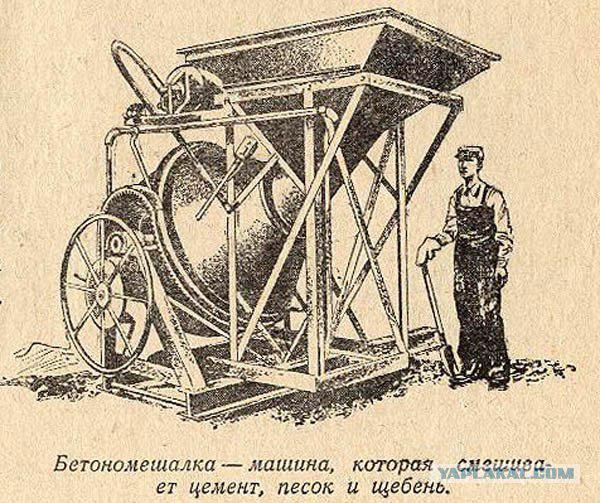
Resources adaptation: resident mobility
Another powerful resource smoothing traffic associated with a purely behavioral factors - resident mobility of citizens, that is, the frequency of change of residence. This change usually occurs in connection with the change of the place of work of senior family members, children get older, retirement, a mass of other everyday circumstances. For a more or less advanced countries and cities inhabitants resident mobility is very high: based on a generation, it is 4-5 or more units.
If you change the place of residence is usually not reduced the number of trips, but their distance. This factor is almost does not change the identity of the urban population mobility, but can drastically reduce kilometricheskuyu mobility, which determines the volume of the total transport work carried out in the city. So, the interest of foreign planners to these indicators is quite natural.
The materials of the General Plan 2025, this factor is not discussed at all. Essentially, this means that its authors rest assured: the mobility of the resident Muscovites remain at the current extremely low level (7). It is unlikely that this is an oversight, rather - a statement of the fact that the market of Moscow real estate will remain in the future as unfriendly to the consumer that today.
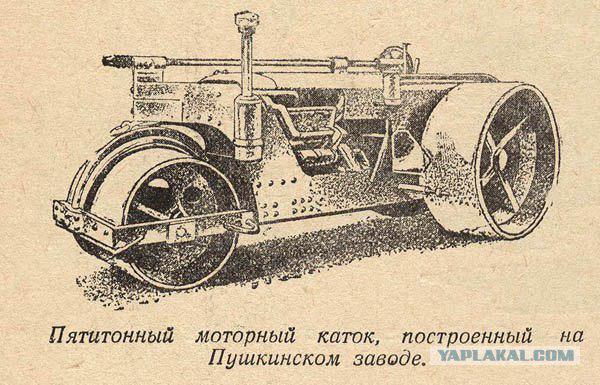
The proportions and balances
In Moscow, grossly violated fundamental importance for the life of the city automobilized proportion distribution of the urban area. As the implementation of the Master Plan for 2025 are unlikely to improve, and likely to become even worse.
It should be noted that the cities of the developed world are divided into three distinct clusters. The first of these, the American-Australian population density per 1 hectare urban (residential) area is in the range of 10 to 50 residents. The share of the MAC account for up to 35% of the urban space. Typical representatives of this cluster of New York (of course, within the metropolitan area), Houston, Los Angeles, Melbourne, Sydney, Toronto, etc.
In the second, the Western cluster population density is in the range of 50-140 inhabitants per 1 ha; MAC road network occupy 20-25% of the territory. In this cluster include Paris, London, Vienna, Munich, etc.
In the third, the Asian cluster density is extremely high - 140-280 inhabitants per 1 ha; the share of the MAC is still only 10-12% of the territory. Typical representatives of the cluster - Singapore, Tokyo, Hong Kong, Seoul.
The logic of cluster formation is obvious: the balance between high-rise buildings and suburban posemeynym resettlement is determined by the presence in the country of the territorial resources. Accordingly, the large territorial resources the country possesses, the less density of population in its metropolitan areas. It is clear that these resources are in the United States, Canada, Australia, more than in Western Europe, while in Western Europe - more than in Hong Kong or Singapore.
Source:
Draft Master Plan 2025 in the transport dimension
Mikhail Blinkin
The other day I happened to be a witness and participant in the discussion, even in part of an updated Master Plan-2025 of the Union of Architects.
I thought that 500 years ago there was a historic division of labor of the architect and design engineer; 100 years ago, with the advent of the mass of the car, another event occurred: craft Urban & Transportation Planning separated from the architecture itself. The first division we are behind the rest of the cities and countries seem to be gone; the second - alas, no.
However, the architectural community unanimously praised Master Plan. The bravest noted his individual shortcomings. The gray-haired classic Soviet architecture dare even say that it is stipulated in the document preservation radial-ring structure - a dead-end solution, and what is needed, they say, no trace of the ring, but the chords and tangents.
However, everyone, including the classic, converged on the fact that the whole project is perfectly good and should be approved immediately.
Master plan - summed up the general opinion on the sidelines of another famous architect - he is like a song: we build and live help.
I will not argue: Master plan really helps to be nice to live for those who build in Moscow. That's just everything else population - hardly ...

History
In 1934, the great Russian urbanist Georgy Sheleyhovsky, obviously not getting into resonance with an era of socialist urban development, he wrote that "people (in contrast to the inhabitants of the zoo!) Are free to choose the place of residence and the way of movement».
Based on the understanding of international experience, he has come to the firm conviction that this (especially valuable in itself!) Freedom of choice of the citizen is directly related to the growth of car ownership and, therefore, transport of self-sufficiency of households. His main conclusion, addressed to fellow planners, is unfortunately ostroaktualnym for Moscow today: "... if motorization came into sharp conflict with the plan, it must fight not with the motorization and the backward forms of transport - insolvent plan." < br />
These words were written relying on intellectual baggage accumulated urbanists and transport in the first decade entering cars in the life of the most advanced cities in the world. Today, this has become immeasurably more extensive luggage. It has social technologies needed for the coordination of interests of different groups of citizens in the process of making critical decisions regarding land use and transport. There is also a typical planning and technological solutions for urban centers, transportation hubs, blocks of residential development; adjusted recipes and planning for functional stratification of the road network, the device of public transport systems and the organization of parking spaces. And yet - the methods of economic, including fiscal driving behavior of citizens and, consequently, the transport demand. Well, and many other useful things, including mathematical models and IT-tools.
This baggage, in principle, allows us to solve the problem indicated Sheleyhovskim freight wealthy urban devices, absorbent arbitrarily high motorisation of households "are free to choose the place of residence and the way of movement».
All the world's mega-cities are living today at around 500-800 (in New York, even 910!) Cars per 1000 inhabitants. In Moscow, the figure is only some 350 units. This publicly available data on the conditions of transportation, environmental externalities, the preservation of cultural and historical attributes of identity show that in most of these cities is a multiple of the situation better than we have (see. Annex 1).
Motorization of the population, which successfully fought the Soviet regime, "came into sharp conflict with the plan," the Russian capital since the mid-1990s. Material Analysis Project Master Plan-2025 (2) suggests that we are not going to approach the standards of transport and wealthy city of devices; on the contrary, we are leaving them farther and farther.

Cars: a cause for bewilderment
In 1992-2008 gg. motorisation rate in Moscow grew an average annual rate of 10-11% and reached the level of the said 350 cars per 1,000 inhabitants. Authors of the General Plan 2025 based on the fact that in 2025 we will reach the mark of 380 units. This forecast implies that the city will grow motorization homeopathic pace of order 0, 6% per year. If the market would have reacted to this hypothesis any serious showrooms in Moscow, close to both the casino and gaming clubs.
I can not judge what is behind this amazing outlook: whether fitting a response arising from the planned rate of development of the road network (MAC) of the city, whether confidence will soon return to fight against motorization to the Soviet style. In any case, this prediction is not confirmed by the experience of a single major city not communist (3).
I note that exactly the same "regulatory" projections made at the end of the Soviet era, allow the city fathers say with conviction that no one will ever be able to assume such a rapid growth in motorization of the population.

Railways: a reason for cautious optimism
Sections of the General Plan 2025, which I was pleased, written on materials of the Moscow underground, and RAO Russian Railways.
I have written repeatedly that it is underground (with all the problems of its functioning and long-term development!) Keeps the city from the collapse in the transport and isolated fragments of territory. State: its development program until 2025 is structurally meaningful and realistic in principle.
In the area of urban railways and planned to do the most important structural breakthrough "development of the existing railway land diameters (Riga Kursk, Kursk, Smolensk, Smolensk-SAVELOVSKY), as well as the creation of new - Kursk Oktyabrsky and Riga-Gorky. Also for the first time it provides for the construction of two underground diameters ("deep feeding") - Yaroslavl and Paveletsky-Kiev-Ryazan ».
It is clear that the feasibility of these plans depends on the strongest fiscal space RAO Russian Railways. However, the main long-term transport planning - this is the correct ideology (4), does not contradict international experience.
In this regard, I note that the ideology of the formation of deep groundwater inputs, docked with the metro, very correct and promising. It is thus arranged off-street public transport system in the advanced foreign metropolises.
In the railway section also provides for "the reorganization of the territories at the stopping points, the creation of new urban areas, the organization of the transport of passengers by road, delaying the construction of parking lots and parking garages," plus the fact - "the organization convenient to subway hubs».
Unfortunately, here there is an obvious gap between the desirable and realistically achievable. Moscow built up the forecourt (or built up) large objects purely non-transport purposes. For example, together with the discussion of the draft of the General Plan 2025 at Paveletskaya square in full swing construction of another shopping mall, which will make their great contribution to the formation of congestion across the approaches to the square and at the same time permanently eliminate is the place for "the transportation of passengers by road" .

Public transport: an occasion for memories
Made by the authors of the General Plan 2025 forecast volumes and structure of passenger traffic is puzzling.
Based on the projections of the above-mentioned high-speed off-street posts, they imply an increase in, absorb, respectively, railways (2 times), and the subway (1, 46 times). Based on its forecast of motorization is undervalued, they forecast a modest (28%) increase in car trips. At the same time the Master Plan-2025 envisages a decline in land transport.
This forecast can only be based on the expectation of tremendous shift in passenger logistics. Today in Moscow, the three-tier scheme prevails: the pedestrian approach + bus (trolley bus) + Subway. Forecasted traffic structure clearly indicates the dominance of two-tier scheme: the pedestrian approach (road trip) + Subway (city w / e). The point, however, is that the transition to such a scheme there are no preconditions for planning as the characteristic step metro and urban railway / or power near-station parking.
Master plan promises that by 2025 residents will drive overland transport with the European quality under conditions not worse than 3 standing passengers per 1 m2 free floor area. Last time I had ever read such forecasts in the programs of the comprehensive building of socialism. Meanwhile, in its sunset in 1989, almost half of the traffic carried out under 6, 67 standing passengers per 1 m2 free floor area, ie at the level of the limit standard adopted by the International Union of Public Transport. Moreover, 15% of traffic took place in conditions worse than limiting technical characteristics of the bus, ie 8 passengers standing on the same square meter. Today, Delivery van routes in the periphery of the city transport passengers around in the same conditions.
Apparently the authors of the General Plan 2025, realizing the unreality of access to European standards for quality of service due to a planned (very modest!) Increase the freight capacity of public transport, resorted to means-tested Soviet forecasters: fit the demand for really affordable offer. Hence, the projected decline in land transport.

Resources adaptation: Model Park & Ride
Mass replacement car trips "home-work" travel model Park & Ride, that is, the transition to a two-tier logistics said: car ride + Subway (city w / e), called in the world is widely recognized important reserve smoothing automobile traffic.
This resource adaptation (unlike many others) discussed in detail in the materials of the General Plan 2025: to the estimated useful life is supposed to "form a cascade of intercepting parking lots with a total capacity of 250 thousand. Parking spaces." Of these total 100 thousand berths lots will be located on the way to the borders of the city, another 150 thousand - in front of the Garden Ring. Immediately, I note that parking at the turn of the Garden Ring can be called intercepting a very big stretch: in this capacity, has consistently failed to work even underground parking available at the Gagarin Square.
As for parking at the boundaries of the city, their construction certainly appropriate; the only question is, where to build them. I have carefully studied the drawings on the territorial areas adjoining the end subway stations: they are already densely packed with shopping and entertainment complexes, and other points of additional traffic generation; wherever there is room, planners partial load area "priority of capital construction projects." I'd like to know where, for example, it is possible to carve out a place for intercepting parking at the underground "South West", "Teply Stan", "textile workers" or "Riverport»!
Some indirect signs indicate that the authors of the General Plan 2025 do not really believe in the prospects of Park & Ride in Moscow. In particular, said the forecast volumes and structure of passenger traffic for 2025 was calculated in terms of passengers, and not in the passenger-kilometers, that is, in terms of identity, not kilometricheskoy mobility (5).
It is, however, evident that the use of Park & Ride model does not change the annual number of passengers transported by car households, but radically changes the parameters of their annual mileage. It seems that the authors of the General Plan 2025 previously considered model the effects of the change of movement is simply irrelevant.

Resources adaptation: equipping the periphery
Planners of the world's mega-cities for decades seeking reserves smoothing and road passenger traffic due to the factors placing jobs and resident household behavior.
According to the famous Russian urbanist A.I.Strelnikova 38% of all the jobs available in the Moscow metropolitan area (6), is concentrated in the central patch, it takes only 6, 5% of the face of the urban area. This incredible concentration of jobs is the most powerful pendulum flows (in the center - in the morning, from the center - in the evening), the problem of development that planners in Moscow are trying to solve the increasing capacity of radial roads.
At the same time they have a natural desire to somehow move to the periphery of the point of attraction of labor trips. Unfortunately, jobs in modern Moscow is very difficult, sometimes impossible, to shift to the periphery for purely transport reasons: density and connectivity MAC fall strictly in our city as the distance from the center.
For 10-15 years of intensive road construction traffic situation on the periphery of Moscow has become not better, but rather worse.
Driving conditions in the peripheral parts of the city (such as contiguity Lublin street in Volgograd prospectus, Ural street to Schelkovskoye highway Novoyasenevskogo prospectus to Profsoyuznaya street or Kotlakovsky travel to Kashirke, as well as in the vicinity of many peripheral metro stations) are not just bad, but demeaning to human dignity. That is why Moscow has not typically live in one of the peripheral zone and work in another - even near; It is better to get to the center!
Alas, the burning issue of the transport arrangement "backyards" of the city in the General Plan 2025 is not only not solved, but not even posed.

Resources adaptation: resident mobility
Another powerful resource smoothing traffic associated with a purely behavioral factors - resident mobility of citizens, that is, the frequency of change of residence. This change usually occurs in connection with the change of the place of work of senior family members, children get older, retirement, a mass of other everyday circumstances. For a more or less advanced countries and cities inhabitants resident mobility is very high: based on a generation, it is 4-5 or more units.
If you change the place of residence is usually not reduced the number of trips, but their distance. This factor is almost does not change the identity of the urban population mobility, but can drastically reduce kilometricheskuyu mobility, which determines the volume of the total transport work carried out in the city. So, the interest of foreign planners to these indicators is quite natural.
The materials of the General Plan 2025, this factor is not discussed at all. Essentially, this means that its authors rest assured: the mobility of the resident Muscovites remain at the current extremely low level (7). It is unlikely that this is an oversight, rather - a statement of the fact that the market of Moscow real estate will remain in the future as unfriendly to the consumer that today.

The proportions and balances
In Moscow, grossly violated fundamental importance for the life of the city automobilized proportion distribution of the urban area. As the implementation of the Master Plan for 2025 are unlikely to improve, and likely to become even worse.
It should be noted that the cities of the developed world are divided into three distinct clusters. The first of these, the American-Australian population density per 1 hectare urban (residential) area is in the range of 10 to 50 residents. The share of the MAC account for up to 35% of the urban space. Typical representatives of this cluster of New York (of course, within the metropolitan area), Houston, Los Angeles, Melbourne, Sydney, Toronto, etc.
In the second, the Western cluster population density is in the range of 50-140 inhabitants per 1 ha; MAC road network occupy 20-25% of the territory. In this cluster include Paris, London, Vienna, Munich, etc.
In the third, the Asian cluster density is extremely high - 140-280 inhabitants per 1 ha; the share of the MAC is still only 10-12% of the territory. Typical representatives of the cluster - Singapore, Tokyo, Hong Kong, Seoul.
The logic of cluster formation is obvious: the balance between high-rise buildings and suburban posemeynym resettlement is determined by the presence in the country of the territorial resources. Accordingly, the large territorial resources the country possesses, the less density of population in its metropolitan areas. It is clear that these resources are in the United States, Canada, Australia, more than in Western Europe, while in Western Europe - more than in Hong Kong or Singapore.
Source:
